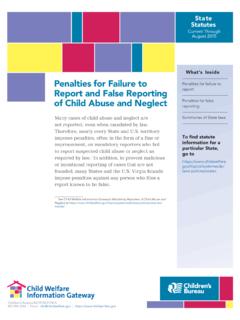Transcription of Recidivism among sex offenders in Connecticut
1 Recidivism among sex offenders in Connecticut State of Connecticut Office of Policy and Management Criminal Justice Policy & Planning Division February 15, 2012 1 Introduction Each February 15 the Criminal Justice Policy and Planning Division of the Office of Policy and Management issues two criminal justice reports: Annual Recidivism Report Correctional Population Forecast Report These reports provide policy makers and front-line professionals with the information they need to continue the progress our state has experienced in recent years. Governor Dannel P. Malloy has set two goals for our state s criminal justice system: reduce crime and maximize efficiency. Recidivism and changes in the correctional population are two important indicators of progress in this regard. This year our report puts the focus on sex offenders . You will see in this analysis a new and somewhat unique perspective. For the first time, we measure offenders with previous sex offense convictions as well as convicted offenders who were originally charged as sex offenders but who were ultimately convicted of other offenses.
2 We believe this will provide policy makers and practitioners with the data and analysis they need to identify offenders with a high risk for committing new sex offenses following release from prison. At the end of the day, our goal is public safety by reducing the level of Recidivism . Based on our analysis, post-release supervision focused on the high-risk sex offenders appears to be a cost-effective strategy to prevent crime. Please feel free to share your ideas about how we can best accomplish these goals going forward. With your help, I am confident that our state can continue to achieve better outcomes with offenders who are incarcerated or who are being supervised by parole or probation officers. As the prison population continues to decline, it is my hope that some of the consequent budgetary savings will be reinvested in the supervision and treatment programs that have demonstrated success. Thank you for taking the time to read this report. Please visit our website for more information on current trends in Connecticut s criminal justice system.
3 Mike Lawlor Under Secretary Criminal Justice Policy and Planning Division State Office of Policy and Management 450 Capitol Avenue Hartford, CT 06106-1365 (Office) 860-418-6394 2 Acknowledgements This report could not have been produced without the help and assistance of many people. First and foremost, the research published here reflects the guidance, advice and feedback of an advisory panel of experts who work on the front lines of State efforts to manage, supervise and treat Connecticut s population of sex offenders . The analysis could not have been accomplished without the data and support provided by the Department of Correction and the Judicial Branch s Court Support Services Division. Without them, it would have been impossible to collect complete criminal histories on 14,398 offenders within the time that was available. The Office of the State Public Defender and the Board of Pardons and Parole provided invaluable access to their staff who explained their important roles in the process.
4 In addition, there are dozens of people from various State criminal justice agencies that helped to move this project forward in one way or another. Finally, it is necessary to acknowledge that this report is funded, in part, through a grant awarded by the Bureau of Justice, Office of Justice Programs at the Department of Justice. The opinions, findings and conclusions expressed here are those of the contributors and do not necessarily represent the views of the Department of Justice. Ivan Kuzyk, Author Director, CT Statistical Analysis Center Office of Policy and Management Criminal justice Policy & Planning Division 3 Table of Contents Introduction by Under Secretary Mike Lawlor 1 Acknowledgements 2 Table of Contents 3 Executive summary 4 Findings Sex offenders in Connecticut 6 Recidivism among 746 sentenced sex offenders 8 Recidivism among sex offender subgroups 14 Releases and discharges in 2005 17 The Sex Offender Registry 18 A final caveat 19 Appendices Advisory panel 20 Methodological questions 21 Sex offender typologies, chart 25 Recidivism 1,395 offenders with a prior arrest for a sex crime 26 Recidivism 896 offenders with a prior conviction for a sex crime 28 Recidivism 746 offenders with a sentence history for a sex crime 29 Recidivism 423 offenders whose last sentence was for a sex crime 31 Recidivism 1.
5 229 offenders w/Sex Treatment Scores higher than 2 33 summary of new prison sentences for sex crimes 36 General criminality among offenders who were released in 2005 37 Sex offenders , parole and special parole 38 Age at first arrest for a sex crime 39 Age at first sex offense resulting in a prison sentence 40 The Connecticut Risk Assessment Board 41 Special Management Unit DOC Community Services Division 42 The Collaborative Model in Connecticut 43 Glossary 45 4 Executive summary Although the term sex offender is commonly used to describe anyone who has been convicted of sex-crimes, it is important to recognize that individuals who have committed sex offenses do not constitute a single, homogenous population. Together they exhibit a wide range of criminal behaviors that may or may not include violence or contact with other persons. As a consequence, the risk, or likelihood, of committing new sex crimes is not consistent across all sex offender types.
6 This study tracked 14,398 men for a five-year period following their 2005 release or discharge from a CT prison in 2005. Every subsequent arrest, criminal conviction or reincarceration event was captured and analyzed to produce the 5-year Recidivism rates for the group. In addition to analyzing Recidivism among all offenders released or discharged during 2005, the study identified five subgroups from the total cohort who were either convicted for sex offenses or thought to have been involved in criminal sexual crimes but not convicted. The five subgroups were: 1,395 men who had had a prior arrest for a sex-related offense 896 men who had a prior conviction for a sex-related offense 746 men who had served a prison sentence for a sex-related offense before being released in 2005 423 men, a subset of the 746, whose last prison sentence before release was for a sex-related offense, and 1,229 men who were assigned Sex Treatment Scores of 2 or higher by the Department of Correction prior to their 2005 release or discharge.
7 In 2005, 746 offenders who had served a prison sentence for a least one sex-related offense were released or discharged from prison. Over the next five years: o 27 ( ) of these men were arrested and charged with a new sex crime. o 20 ( ) were convicted for new sex offense, and o 13 ( ) were returned to prison to serve a sentence for a new sex crime. The sexual Recidivism rates for the 746 sex offenders released in 2005 are much lower than what many in the public have been led to expect or believe. These low re-offense rates appear to contradict a conventional wisdom that sex offenders have very high sexual re-offense rates. The real challenge for public agencies is to determine the level of risk which specific offenders pose the public. 5 Recidivism data for each sex- offenders subgroup is presented in the Appendix. In 2005, 37% of non-sex offenders completed their sentences in prison. In contrast, 79% of the 746 sex offenders who had served a prison sentence for a new sex crime were discharged directly from a prison facility at the end of their sentences (EOS).
8 The reason the EOS discharge rate was so high for sex offenders reflects two facts: 1) the DOC did not release TS-eligible sex offenders into the community and 2) sex offenders were not accepted in most of the DOC s residential, halfway house network. Almost 50% of sex offenders were sentenced to probation at the completion of their sentences compared to 33% for non-sex offenders . According to this analysis, arrest on a prior sex charge was the single best predictor of being sentenced to prison for a new sex crime in the five years following release from prison. Of the 1,395 offenders who had been arrested on sex charges before 2005, were sentenced to prison for new sex offenses within 5 years. This compares with a rate among offenders who had a prior conviction for a sex crime, and a rate for offenders who had served a prison sentence for a prior sex crime. This finding warrants further study. It suggests that conviction and incarceration for a sex crime exerts a positive impact on reducing future sex crimes.
9 The DOC-Sex Treatment Score was the 2nd best predictor of sexual Recidivism . among the 1,229 offenders with Sex Treatment Scores of 2 or higher, were sentenced to prison for new sex offenses. Connecticut employs a unique collaborative approach in supervising and treating sex offenders in the community. The approach links parole officers and probation officers, victim advocates and a non-profit provider of sex offender treatment and programming. Together these organizations design oversight and supervision plans for every offender. Some sex offenders have extensive, violent non-criminal histories. among the 195 offenders who had been convicted for Sex Assault 1 prior to 2005, had also served a prison sentence for a burglary related crime; had served a sentence for robbery. The high incidence of burglaries and robberies among this group indicates both a heightened willingness to use force and overstep boundaries. among the entire population of male prisoners released in 2005, only 16% had been convicted of burglary-related charges and less than 8% had been convicted for a robbery.
10 6 Sex offenders in Connecticut The following table contains data supplied by the CT State Police, the Department of Correction, CSSD Adult Probation and the Special Offender Management Unit at the DOC Division of Parole. It is published here to provide readers with an appreciation for the size of the sex offender population in CT. Although the term sex offender is commonly used to describe anyone who has been convicted of sex-crimes, it is important to recognize that individuals who have committed sex offenses do not constitute a single, homogenous population. Together they exhibit a wide range of criminal behaviors that may or may not include violence or contact with other persons. Sex offenders vary by age, ethnicity and social background. They also vary by their motivations, the nature of their crimes and by the extensiveness of their non-sex-related criminal histories. As a consequence, the risk, or likelihood, of committing new sex crimes is not consistent across all sex offender types.















